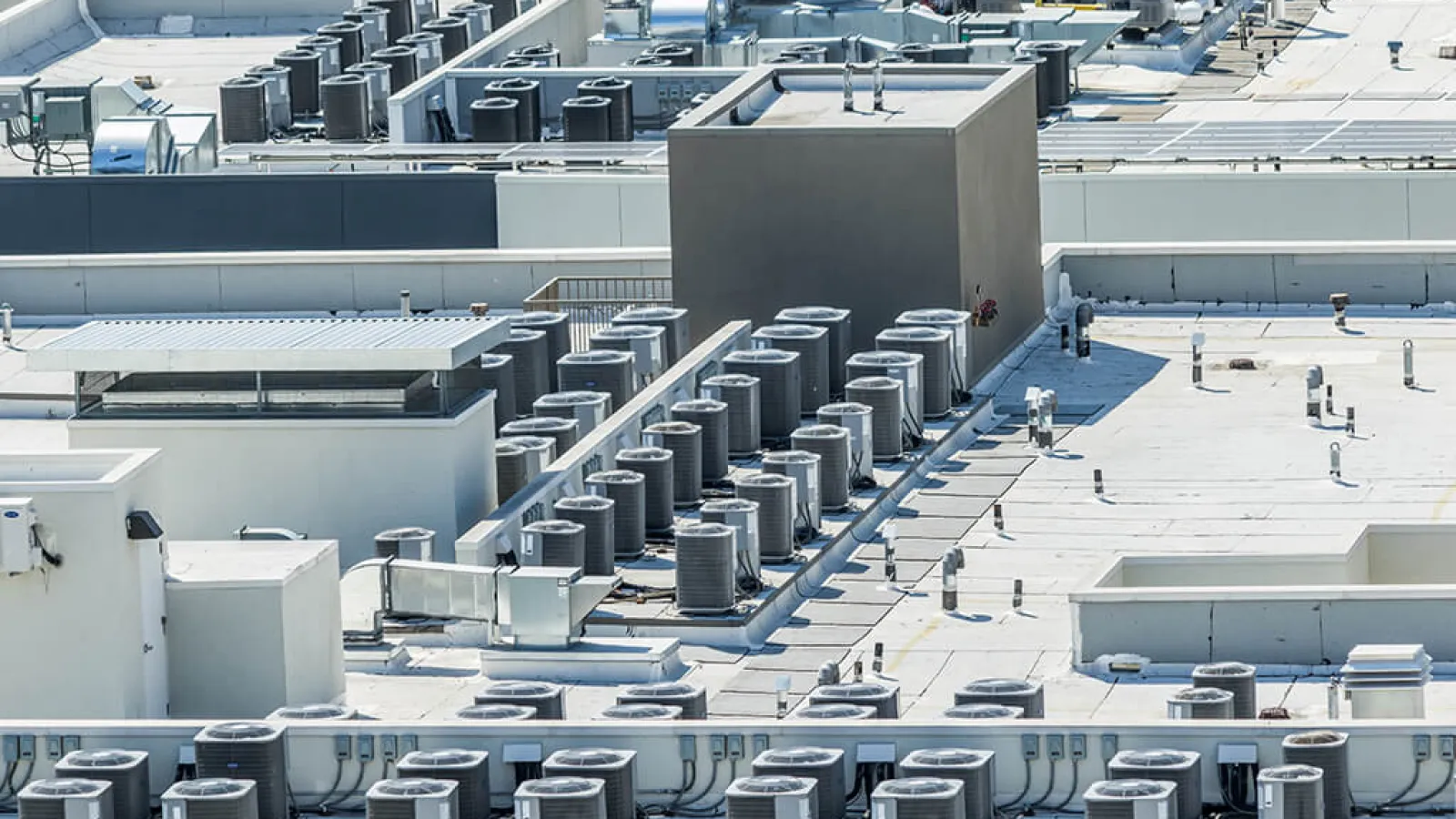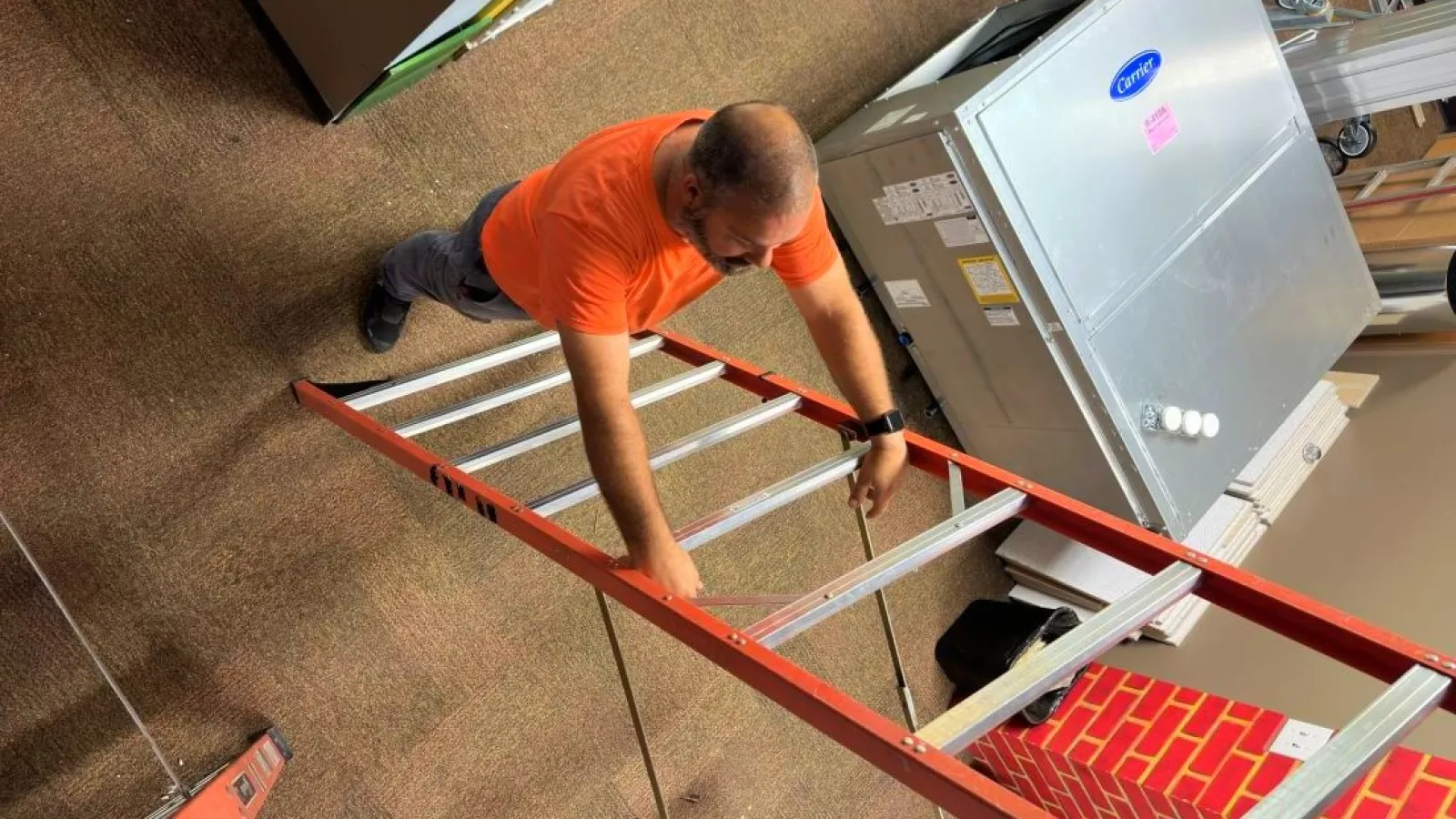(Updated December 2020) Whether you own a building or manage facilities, you might wonder how the cost of a new commercial HVAC system impacts your bottom line. After all, your commercial HVAC system is critical to the operation of your business.
A quality HVAC system maintains a comfortable working environment and an inviting experience for customers. In some applications, properly functioning heating and cooling systems are critical for operations and production. The approximate cost of a new commercial HVAC system for your facility depends on several factors.
We’ll cover what impacts commercial HVAC system pricing and how you can keep commercial HVAC costs in check with an investment in preventive maintenance. A customized HVAC maintenance plan also catches small problems early and saves you the headache of an expensive breakdown. If your current HVAC system is older and failing to keep your business or building comfortable, you may need commercial HVAC installation services from Estes Services. Estes also offers HVAC repair services for both commercial and residential properties at a price that you can afford.
What Determines Commercial HVAC Prices?
- Brand
- Type of HVAC Unit
- Labor and HVAC installation costs
- Commercial building size
- Type of business/activity
Which Brand You Choose Impacts the Price of Commercial HVAC Systems
Many HVAC companies partner with specific equipment manufacturers, which are usually more stringent in the residential division. Commercial HVAC is a bit different due to the diversity of equipment, which can be used for light commercial to major cooling towers and rooftop units for multi-story structures.
For example, Estes partnered with Carrier® many years ago and installs a majority of their HVAC equipment because the energy efficiency, quality and warranty coverage are all excellent.
Estes also uses energy-efficient Mitsubishi ductless units to solve certain HVAC issues for commercial clients, such as older buildings or properties with fluctuating occupancy such as places of worship.
Estes Commercial uses these brands as well: Liebert, Aaon, Trane, Lennox, and Honeywell, among others. At Estes, we source the most appropriate equipment for the job, regardless of the brand.
The Type of HVAC Unit Affects Costs
Do you have a small commercial property similar to a large house? Do you need packaged units for an apartment building or hotel property? How about cooling towers and massive rooftop units?
On top of that, commercial heating and cooling systems operate using various technologies, such as variable or constant air volume. Some don’t use air at all. We encourage a personal assessment from a trained commercial HVAC technician to determine the type of HVAC system that is best suited for your commercial property.
Variable Air Volume (VAV) Systems
VAV commercial HVAC systems are highly efficient. Similar to a high-end and energy-efficient HVAC unit in your home, variable systems adjust the amount of airflow based on the current room temperature. They are more responsive and can make minor adjustments based on variable-speed motors. They are more energy-efficient and create more comfort for occupants.
Constant Air Volume (CAV) Systems
CAV systems consist of single-split and multi-split systems and are common in commercial systems. Similar to residential systems, they use an indoor air handler or blower with an outdoor AC compressor.
They are often best for smaller commercial buildings with few rooms to heat and cool. Like single-speed residential systems, CAV systems have two modes: on and off. As a smaller commercial heating and cooling system, they cost less initially but are also less energy efficient, which means they’ll cost more to run.
Variable Refrigerant Volume (VRV) Systems
VRV systems really flip the concept of heating and cooling. They don’t push air through the building; they use a system of piping that allows coolant to circulate. Commercial properties use these systems to heat and cool individual rooms as needed.
Labor and HVAC Installation Costs Vary Widely
Installation of commercial HVAC systems impacts pricing, so consider the degree of difficulty. Do you own a historic building? In order to install a commercial furnace and an air conditioning system, will special permits be involved? Older buildings, for example, often have tricky architectural elements to work around. Ductwork might need to be creative or require additional techs to fabricate and install.
Is a crane necessary? Rooftop installations, for example, are different than a packaged unit in the parking lot. When comparing quotes, see if insurance is included. Some contractors add it as a line item later while others include it in the labor fee. Expect to pay more for difficult jobs such as these.
Commercial Building Size is One of the Biggest Factors for New Commercial HVAC Costs
Again, like residential HVAC installations, bigger is not better. This is another area where professional HVAC commercial contractors are invaluable. Do not buy an air conditioner, for example, without a commercial HVAC professional performing the appropriate calculations.
Your new commercial heating and air conditioning unit must not be too big or too small. Too big and it cycles too quickly, causing it to start and stop before fully cooling every corner of every room. Plus, the stress of constant short cycling shortens the HVAC unit’s life span with excess wear and tear. HVAC units that are too large for the provided space also increase the risk of problems like frozen evaporator coils.
If the system is too small, it runs constantly, trying to meet unrealistic temperature expectations. Don’t wait for soaring energy bills or shutdown aggravations to realize your new system is the wrong size!
Want to make a quick guess as you research further? Here’s a simplistic formula. You can determine cooling needs by dividing the square footage for the whole building by 500. Then, multiply the answer by 12,000 to estimate how many BTUs central air conditioners should move.
Type of Business or Activity Impacts New Commercial HVAC Estimates
Other major factors are insulation, occupancy, and activity. The amount of or type of insulation affects the heating and cooling needed from a new commercial HVAC system. Modern and comprehensive insulation retains more BTUs and reduces the heating and cooling load.
An office with workers performing light clerical work has different requirements than a restaurant where men and women are actively on their feet and contain heat-generating equipment.
Server rooms are well known, for example, for requiring special air conditioning unit equipment and even separate controls. A manufacturing line is different than a healthcare facility with a majority of inactive elderly patients.
In general, each human equals 400 BTUs, but activity could skew this higher or lower. Again, this is where a customized plan comes into play.
Bonus Factors
Automation and Controls
One of the most popular upgrades in commercial HVAC is building automation and controls. Whether it’s a small company or an entire campus, automation and controls allow property owners or facility managers to capture usage data and adjust settings remotely.
You can use data to find areas of energy waste and let it alert you to abnormal behavior or the need for preventive maintenance. Highly sophisticated HVAC systems include controls for security systems, lighting, ventilation, and exit/entry monitoring.
SEER Rating
The Seasonal Energy Efficiency Ratio, or SEER rating, determines the average cooling output a new system provides compared to how much energy it consumes. The higher the Seasonal Energy Efficiency Ratio, the more energy-efficient central air conditioners are. Expect to pay more money for a higher SEER air conditioner, but you’ll recoup much of that money in the form of savings on your monthly energy bill. Make sure to discuss SEER ratings with a certified heating and cooling professional.
Ready for Commercial HVAC System Replacement?
Commercial HVAC units vary in cost, as equipment capacity, features and system type affect the unit’s price tag. Piping and ductwork needs, UV lamps, air purifiers, automated ventilation, controls and HVAC installation labor all make up the final cost of commercial HVAC unit replacement.
Commercial HVAC systems can be highly customized based on the needs of the business, depending on the size of the facility and other factors, so there really is no average number for commercial HVAC installation cost.
When replacing your commercial HVAC unit, ask your contractor for a breakdown of HVAC costs so you can see every component affecting the final price. Ask questions about what is needed and the benefits you can expect from the product recommendations.
If your business is eligible, you may make use of recent tax code changes. In section 179, it says you may deduct the entire cost of a commercial HVAC unit in a single year. This is a big change from the previous system of taking the depreciation over 39 years.
This allows you to upgrade your system sooner and free up cash from a lowered tax bill. For specifics, consult your tax professional.
Commercial HVAC Maintenance Preserves Your Investment
The best way to avoid the expenses of commercial HVAC unit replacement is to take care of the systems you have in place. Commercial HVAC unit maintenance is the best way to do this. Maintenance is proven to improve performance and efficiency. It also helps users avoid breakdowns and other expenses of early replacement.
Commercial maintenance can be tailored to the needs of your business and your heating and cooling system equipment. Our NATE-certified commercial HVAC experts work with your facility to identify the current and ongoing needs of HVAC systems, set performance and energy-consumption goals, and provide you with the maintenance solutions needed to help achieve them.
Estes Commercial helps clients perform preventive maintenance instead of reactive maintenance. This eliminates minor issues with your equipment and controls your costs.
Commercial HVAC unit maintenance costs also vary from one business to the next because no two commercial HVAC units are the same, nor are the needs of the business. Commercial HVAC preventive maintenance is typically bi-annual, performed once in the spring and again in the fall.
A preventive maintenance service contract customized for your business ensures your systems receive needed care when appropriate throughout the year, plus it offers reliability and savings. Expect to invest a few hundred dollars per year on preventive maintenance visits with an HVAC technician. Additionally, plan for maintenance costs to cover filter changes and other needs, too.
Save Money with Commercial HVAC Unit Maintenance
Commercial HVAC unit maintenance helps your business generate substantial savings on your heating and cooling use:
- Maintenance improves system performance and reduces energy consumption. When efficiency goes up, this lowers your energy costs and operational expenses.
- Preventive maintenance solves minor repair needs before they lead to system breakdowns. Fixing small issues during a maintenance tune-up typically costs much less than when you’re calling for repairs due to system failure – which also cost you productivity or even inventory damage.
- Maintenance works to extend the service life of your commercial HVAC unit, so your business doesn’t burn money on new equipment before expected.
For New Commercial HVAC Cost Estimates, Call Estes
Invest in energy-efficient commercial HVAC unit maintenance for better performance and efficiency, while preventing early replacement expenses. Contact Estes Commercial to schedule an estimate for a customized HVAC plan today. We’ll take the time to survey all your options, evaluate the best brand or solution for your needs and review estimates in detail.
We apply Estes’ 70 years of experience to our work with commercial properties throughout the greater Atlanta area, including healthcare facilities, schools, daycare centers, places of worship and office buildings. Our technicians are skilled at taking on all types of HVAC projects.


